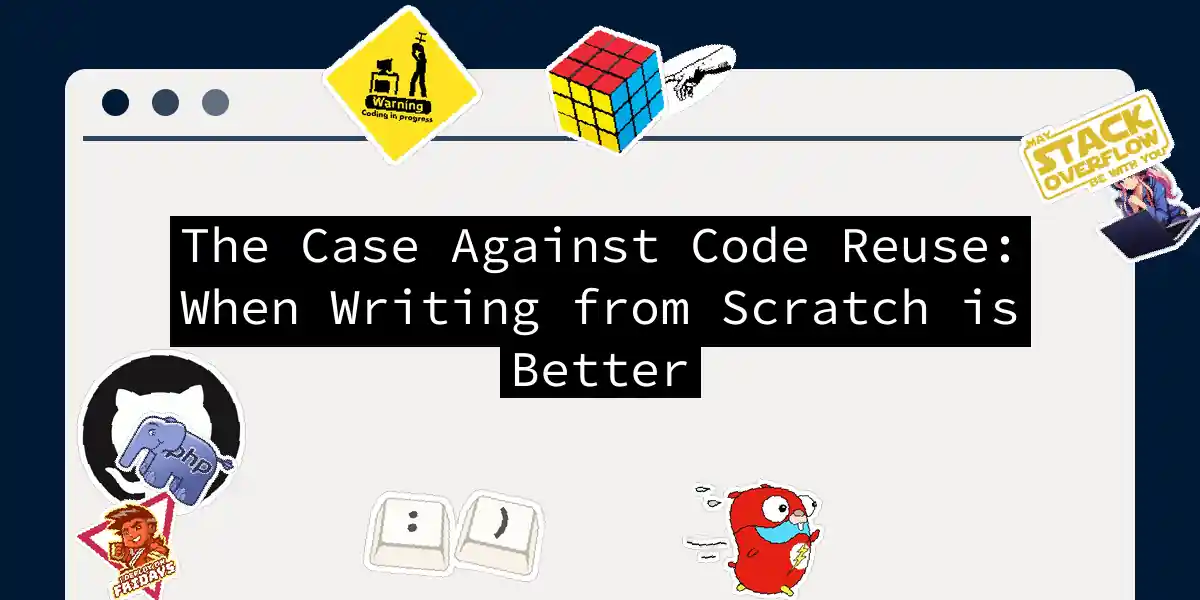We’ve all been there - staring at a 10-year-old utility class that’s become the Frankenstein’s monster of your codebase. “But it’s reusable!” your teammate insists, as you discover it now contains 47 optional parameters and a hardcoded reference to IE6. Let’s explore when writing fresh code might save your sanity (and your stack).
The Hidden Costs of Reuse
1. The Overgeneralization Trap
Reusable code often starts with good intentions:
// The "Swiss Army Knife" string processor
function processText(
input: string,
options: {
trim?: boolean;
reverse?: boolean;
leetify?: boolean;
emojify?: boolean;
sarcasmCase?: boolean;
// ...27 more options
}
) { /* ░▒▓ mysterious magic ▓▒░ */ }
Within months, this becomes unmaintainable as new teams add niche requirements. I once found a date formatter that handled Mayan calendars “just in case.”
2. Performance Penalties
Reused code often carries baggage:
# "Efficient" CSV parser inherited from fintech team
def parse_data(file):
apply_currency_conversion()
validate_sec_compliance() # We're parsing cat memes, Janet!
generate_audit_log()
return actual_parser(file)
Benchmark showing custom vs. reused code latency:
When to Burn It Down (And Start Fresh)
Scenario: Building a real-time game leaderboard
Problem: Reusing “enterprise-grade” reporting module
Symptoms:
- 300ms response time for 10 players
- Dependency on Oracle DB driver
- Features: pagination, audit trails, PDF export
Step 1: The 3-Question Test
- Does >40% of the code go unused? 🗑️
- Are we working around the code more than with it? 🔧
- Does it introduce unwanted dependencies? 🕸️
Step 2: The Great Divorce
# 1. Create isolation layer
npx create-sandbox ./legacy-graveyard
# 2. Benchmark critical paths
wrk -t4 -c100 -d30s http://localhost:3000/api
# 3. Rewrite slice-by-slice (not all at once!)
function miniParser(file) {
return [file.read(), "🏆"];
}
The Art of Strategic Duplication
Case Study: The “Quick” CMS Migration
A client insisted on reusing their existing content renderer for a new React frontend. After 3 weeks of fighting with AngularJS interoperability, we:
- Created a slim renderer API boundary
- Cloned just the Markdown parsing logic
- Achieved 90% smaller bundle size
Two years later, they upgraded the legacy system independently without frontend changes. Strategic duplication created decoupling.
When Your Code Needs Therapy
Ask these questions before reusing:
| Metric | Reuse Candidate | Custom Solution |
|---|---|---|
| Development Time | 2 days | 3 days |
| Runtime Perf | 220ms | 38ms |
| Maintenance | Weekly tweaks | Rare changes |
| Dependencies | 17 packages | 2 packages |
The Maintenance Paradox
A team at a major cloud provider shared this timeline:
- Month 1: Save 2 weeks by reusing logging module
- Month 6: Spend 3 weeks debugging queue overflows
- Year 1: 40% of incidents traced to reused component
As the Zen of Python says: “Flat is better than nested… unless nested prevents dependency hell.”
Next time you reach for that “trusty” utility library, ask: Are we saving time, or just borrowing technical debt with compound interest? Sometimes the most professional choice is to look that legacy code in the eye and say “New phone, who dis?” 🚀🔥
